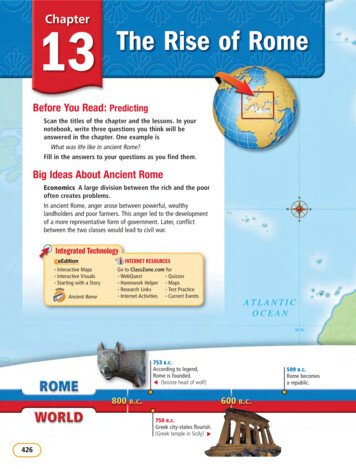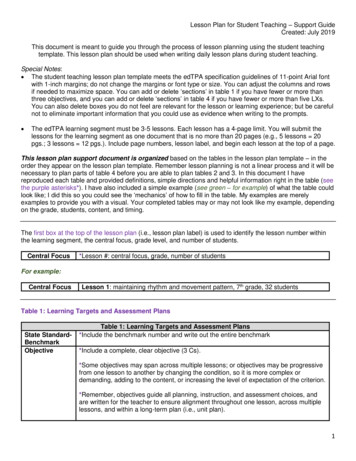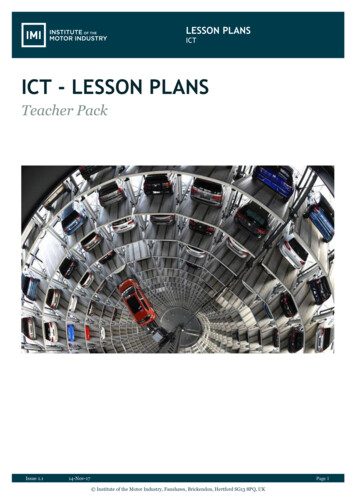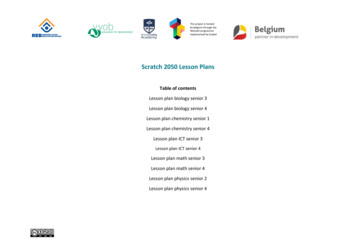
Transcription
Rome Lesson Plan 4: Mapping an EmpireIntroduction:In this lesson, students will compare a map of the Roman Empire in 44 BC with one ofthe Roman Empire in 116 AD. Using these two maps as a reference, students will usecritical reading skills to learn about the expansion of the Roman Empire during that timeperiod. Relying on the resources available on The Roman Empire in the First CenturyWeb site [http://www.pbs.org/empires/romans/index.html], students will learn aboutwhich countries/ territories were conquered by each Roman emperor. After reviewingbasic map skills and information, students will use the data collected to construct theirown maps documenting the historical expansion of the Roman Empire. They will thenuse the data represented on the map to draw conclusions about the effectiveness ofspecific emperors as well as the positive and negative aspects of expanding the RomanEmpire so much in such a short time.Subject Areas:World History, Social Studies, Geography, and Communication ArtsGrade Level: 6-12Lesson Objectives:Students will:1. Compare two different maps and make estimates about the growth of the RomanEmpire during the first century.2. Use primary source materials to gather facts about the expansion of the RomanEmpire including the names of conquered countries/territories, the approximate datethese lands were added to the empire, and which emperor was responsible for theseexpansions.3. Participate in a review of map skills and the key components of maps to prepare forcreating their own maps.4. Work in pairs to create maps that show the historical expansion of the RomanEmpire between 44 BC and 116 AD.5. Analyze the maps they have created to draw conclusions about the expansion of theRoman Empire and how its size may have contributed to its downfall.6. Complete a series of written response questions with their partner based on theiranalysis of the map they created.7. Participate in a class discussion about the expansion of Rome using the conclusionsthey reached from analyzing the map and their answer to the written responsequestions.Get More at: www.pbs.org/empires/romans2006 Public Broadcasting Service All Rights Reserve
Relevant National Standards:McRel Compendium of K-12 Standards Addressed:World HistoryStandard 9: Understands how major religious and large-scale empires arose in theMediterranean Basin, China, and Indian from 500 BCE to 300 CE.Historical UnderstandingStandard 1: Understands and knows how to analyze chronological relationships andpatterns.GeographyStandard 1: Understands the characteristics and uses of maps, globes, and othergeographic tools and technologies.Standard 2: Knows the location of places, geographic features, and patterns of theenvironment.Standard 3: Understands the characteristics and uses of spatial organization of Earth’ssurface.Standard 4: Understands the physical and human characteristics of place.Standard 9: Understands the nature, distribution, and migration of human populationson Earth’s surface.Standard 12: Understands the patterns of human settlement and their causes.Standard 17: Understands how geography is used to interpret the past.Language ArtsWritingStandard 4: Gathers and uses information for research purposes.ReadingStandard 5: Uses the general skills and strategies of the reading process.Standard 7: Uses reading skills and strategies to understand and interpret a variety ofinformational texts.Listening and SpeakingStandard 8: Uses listening and speaking strategies for different purposes.Thinking and ReasoningStandard 1: Understands the basic principles of presenting an argument.Standard 3: Effectively uses mental processes that are based on identifying similaritiesand differences.Get More at: www.pbs.org/empires/romans2006 Public Broadcasting Service All Rights Reserve
Working with OthersStandard 1: Contributes to the overall effort of a group.Standard 4: Displays effective interpersonal communication skills.Estimated Time:This should take two to three 90-minute class periods or four to five 50-minute classperiods, plus additional time for extension activities.Materials Needed: If you wish to purchase a copy of The Roman Empire in the First Century program,visit the PBS Shop for Teachers [Purchase DVD or Video].Map of the Roman Empire in 44 BC sar.html].Map of the Roman Empire in 116 AD jan.html].Internet access for conducting research.Mapping an Empire Note Taking Sheet [Download PDF here (160k)], part of thislesson plan.A large pull-down map that can be used to identify key features necessary on a map.Mapping an Empire Assignment Sheet [Download PDF here (160k)], part of thislesson plan.One poster board for each pair of students.Assorted art supplies such as colored pencils, markers, crayons, and rulers.Procedures:1. Begin by providing students with a map of the Roman Empire as it appeared in t/caesar.html], after the death ofCaesar. Using a current world map, discuss which countries made up the empire atthis time so that students can get an idea of its size and location.2. Using the map of the Roman Empire jan.html], show students how much the empiregrew from 44BC until 116AD. Have them make estimates about how much theempire grew in size during this time period and discuss these estimates by analyzingthe maps as a class.3. Explain to students that the Roman Empire grew over time under various emperors,and that some were more successful than others in conquering neighboring lands.Get More at: www.pbs.org/empires/romans2006 Public Broadcasting Service All Rights Reserve
4. Direct students to the /timeline01.html] on The Roman Empirein the First Century Web site [http://www.pbs.org/empires/romans/index.html]. Usethe timeline along with other features on the site: Age of Augustus ]Empire Reborn tml]Emperors .html]Social Order ml]Enemies and Rebels html]Use the Related ors/lesson4.html#resources] in thislesson plan to work in pairs to discover when various countries/territories wereadded to the empire.Record this information on the Mapping an Empire Note Taking Sheet [DownloadPDF here (160k)]. Note: This activity could be done as a class to ensure accuracy ofinformation for all students.5. As a class, discuss the information recorded on the note taking sheet. Encouragestudents to make corrections to their data if necessary and record any importantdates omitted from their notes. Discuss which emperors seemed to experience themost success in expanding the empire. This is also a good time to talk about keybattles and military leaders that were important in the expansion of the empire.6. Next, take time to review important information that is included on maps so that theycan be easily interpreted. These items could include: Title of mapYears that the map representsA compass roseScale of milesMost importantly, a legend for determining what the markings and colors on themap representLabels on physical features such as country names, bodies of water, mountainranges, etc.Use a large classroom map to illustrate this information for students.7. Now that students have completed their study of the growth of the Roman Empire,distribute the Mapping an Empire Assignment [Download PDF here (160k)] sheet toall students. Review the requirements of the assignment as a class. Then provideGet More at: www.pbs.org/empires/romans2006 Public Broadcasting Service All Rights Reserve
students with classroom time to construct their maps. Stress the importance ofincluding key information and making maps neat and easy to read.8. When maps have been completed, have students work with their partners to answerthe following questions. Each student should turn in a paper for this assignment. Based on what you learned from your research and what your map shows, whichemperor do you feel was most successful in expanding the Roman Empire?Why?Looking at the map you have created, why do you think it was so difficult for theRomans to maintain control of the empire? List and explain as many reasons asyou can.How do you think the sheer size of the Roman Empire contributed to itsdownfall?Do you think the Roman Empire could have been more powerful if it had focusedless energy on expansion and more energy on other aspects of the country’sgrowth? Why?9. Collect the written responses from each pair and end the class by facilitating adiscussion about the three written response questions from procedure step eight.This should help students see the challenges faced by Roman emperors in theirquest to become a world power and maintain that power.10. Post maps on the walls around the classroom and use them as a reference as youcontinue to study the Roman Empire.Assessment Suggestions:1. Students could earn participation grades for class discussion activities.2. A completion or accuracy grade could be assigned for the Mapping an EmpireNote Taking Sheet.3. Grades for accuracy and neatness could be assigned for the Mapping an EmpireAssignment using percentages, and point checklist, or a scoring guide.4. A completion or accuracy grade could be assigned for answers to the writtenresponse questions based on the map analysis.Extension Activities:1. Using the map of the Roman Empire in 116 AD jan.html], add content about the land and itspeople. Create symbols to represent major cities that were part of the empire, createa list of cultures and nationalities represented, list the languages spoken by thepeople of the Roman Empire, and record the types of natural resources available inthe Roman Empire. Discuss how Rome might have used the people and resourcesGet More at: www.pbs.org/empires/romans2006 Public Broadcasting Service All Rights Reserve
differently to make the country stronger. Using this data, refer back to some of thewritings featured in the Virtual library.html] and discuss why someRomans may have felt they were superior to residents of the conquered lands.2. Compare the expansion of the Roman Empire with the expansion of other greatcivilizations throughout history. How do the Romans compare with the ancientEgyptians? The dynasties of China? The Incas, Aztecs, and Mayans? Theexpansion of the United States? Create a series of maps or graphic organizers thatcompare the similarities and differences between these great civilizations.Related Resources:The Roman Empire Web site provides a series of maps organized by date to show the expansion of the empire overtime. WorldAtlas.com [http://www.worldatlas.com/aatlas/world.htm] provides a variety ofmaps and map resources that are printable. These can be used to illustrate variousregions of the world, countries, and map features. your classmates.Get More at: www.pbs.org/empires/romans2006 Public Broadcasting Service All Rights Reserve
In this lesson, students will compare a map of the Roman Empire in 44 BC with one of the Roman Empire in 116 AD. Using these two maps as a reference, students will use critical reading skills to learn about the expansion of the Roman Empire during that time period. Relying on the resources available on The Roman Empire in the First Century











